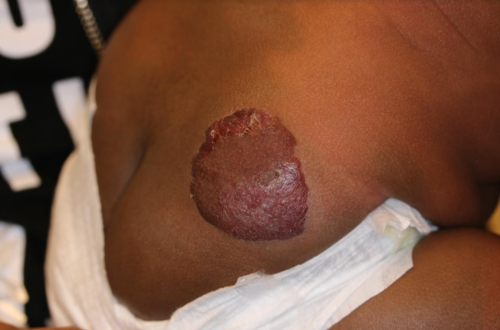
Infantile Hemangioma
Farinoosh Dadrass, MD, MS and Brandi Kenner-Bell, MD
What are infantile hemangiomas?
Infantile hemangiomas are collections of blood vessels that come together to form a growth on the skin. Most infantile hemangiomas appear in the first few weeks after birth. They often begin as pale or red areas on the skin that start to grow larger and more raised over the first few months of life. Infantile hemangiomas on the surface of the skin (called superficial infantile hemangiomas) are typically bright red. In skin of color, this may look more dark red or purple.1 Infantile hemangiomas that are located deeper within the skin (called deep infantile hemangiomas) will look like a soft, round skin-colored or bluish lump, which may be hard to appreciate in darker skin.1 Some infantile hemangiomas may have features of both superficial and deep infantile hemangiomas, and these are known as mixed hemangiomas.1 Rarely, infantile hemangiomas may involve other parts of the body, most commonly the liver.1 This can be diagnosed by an ultrasound.
Though hemangiomas are benign (not cancerous), they can occasionally bleed, or the hemangioma can breakdown (called ulceration). Additionally, depending on their size and location, infantile hemangiomas can rarely affect other things such as eating, vision or breathing.
Infantile hemangiomas gradually start to improve around 6-18 months of age. Almost half of them will have greatly improved by the time a child is five years old and the majority are significantly improved by ten years of age.2
What is the cause of infantile hemangiomas?
Infantile hemangiomas are seen in up to 12% of infants prior to one year of age.2 It is not known what causes infantile hemangiomas.
How do I know if my baby has an infantile hemangioma?
Infantile hemangiomas can be diagnosed by a physician based on the history of symptoms and appearance of the growth on the baby’s skin. If a physician is unsure, they may use an ultrasound to better look at the growth and/or biopsy the growth to confirm the diagnosis.1
What treatments are available for infantile hemangiomas?
Most infantile hemangiomas do not need to be treated.2,3 For those that do require treatment, there are topical (applied to the hemangioma), injected, and oral (taken by mouth) medicines. Your doctor might suggest topical or injected steroids or topical beta-blockers (such as timolol which is traditionally used to treat glaucoma or elevated pressure in the eyes).2,3 For more serious hemangiomas, your doctor might recommend oral steroids or oral beta-blockers (such as propranolol which is traditionally used to treat high blood pressure).2,3 Laser can be considered for bleeding or ulcerated hemangiomas.3 Surgery is a rare choice, but often used later to correct defects in the skin left behind by healed hemangiomas.3
Additional Resources
https://www.aad.org/public/diseases/a-z/birthmarks-symptoms
https://pedsderm.net/site/assets/files/1028/2_spd_infantile_hemangiomas_web_final.pdf
https://www.mayoclinic.org/diseases-conditions/hemangioma/symptoms-causes/syc-20352334
References
- Rodríguez Bandera AI, Sebaratnam DF, Wargon O, Wong LF. Infantile hemangioma. Part 1: Epidemiology, pathogenesis, clinical presentation and assessment. J Am Acad Dermatol. 2021;85(6):1379-1392. doi:10.1016/j.jaad.2021.08.019
- Leung AKC, Lam JM, Leong KF, Hon KL. Infantile Hemangioma: An Updated Review. Curr Pediatr Rev. 2021;17(1):55-69. doi:10.2174/1573396316666200508100038
- Sebaratnam DF, Rodríguez Bandera AL, Wong LF, Wargon O. Infantile hemangioma. Part 2: Management. J Am Acad Dermatol. 2021;85(6):1395-1404. doi:10.1016/j.jaad.2021.08.020

Cutis Journal
Read published peer-reviewed articles written your by Skin of Color Society members

Did You Know
Skin of color patients comprise the majority in California, New Mexico and Texas…and soon will be the majority in Arizona, Nevada, Georgia, New York and Florida.
By 2042, more than 50% of the US population will have skin of color.




